11 Best first-time Europe itineraries for 1, 2, or 3 weeks
Europe is going to be very busy in the summer of 2024 as the world is back to normal and travel demand is higher than ever. One other key factor is that most European currencies are still hovering at lower levels historically compared to the US dollar, which means that Europe will feel somewhat cheap again this year. In fact, according to our World Backpacker Index, European cities like Lisbon, Madrid, and Munich are about 30% cheaper to visit than Boston, Chicago, and New York City. In other words, flying to Europe might seem expensive, but most things will be cheaper once you get there compared to the costs of visiting a large US city.
Below you’ll find 11 of the most popular and best itineraries for a first visit to Europe. Your first visit is not really the time to be different or creative, and the famous destinations tend to be popular for a reason. In other words, it’s kind of silly to visit, say, Bulgaria, if you’ve not yet been to France or Italy. I lay out the best options along with how long to stay in each place as a general guide. I also discuss Mediterranean cruises, which can actually be an amazing way to see a lot of Europe on your first visit, especially if you don’t like going back and forth to train stations and airports every 2 or 3 days.
For a bit of fun you might be interested in the cheapest 5-star hotels in Europe, which start at US$80 per night for really nice hotels. It helps show that if you choose some of the cheaper cities, you can treat yourself to some luxury that you can’t afford in most other places.
This article was last updated in March, 2024.
There are 11 starter itineraries described in detail below
- Classic London and Paris
- England and Scotland
- Paris and Italy
- Mediterranean cruise
- France, Belgium, and Netherlands
- Paris and elsewhere in France
- Italy
- Spain
- Germany
- Switzerland
- Best of cheap eastern Europe
For each itinerary there are suggestions of other destinations that are easy to add on to the main cities.
Note: This article was most recently updated in March, 2024
Building the best itinerary for your first trip to Europe
Below there are 11 popular itineraries for one week in Europe. If you’ve only got a week then choose one of them and assume you’ll return again to conquer more of this amazing part of the world. If you’ve got more time then you can choose from some of the top add-on suggestions for each one.
Start in the most famous cities
Your first visit to Europe is no time to try to be different or edgy. I recommend that you focus on these 5 great cities before you start branching out into cheaper or more obscure places.
Keep your travel days to a minimum
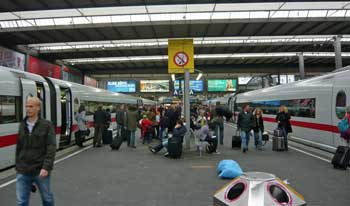
Spend 3 (or 4) nights in almost every major city
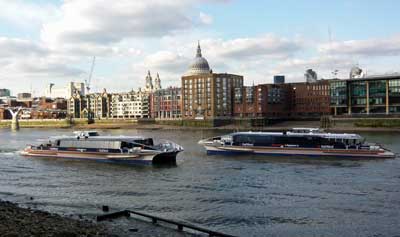
So many first-time visitors are initially planning on spending only 1 or 2 nights in major cities that I wrote a detailed explanation of why 3 nights is ideal for almost all European cities, even if you want to see as much as possible.
3 (or 4) nights will be enough for any city on your first trip
Most first-time visitors are tempted to move too quickly, but it can also be a mistake to move too slowly. It’s really amazing how much you can see in two full sightseeing days. If you spend too long in one city you’ll end up seeing things that are way down your list, while you could be in another city seeing things at the top of your list there.
Choose cities that are easy to reach from each other
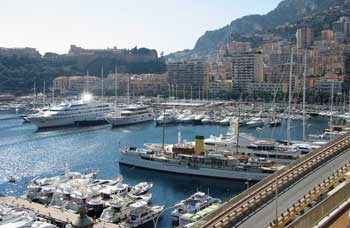
For your first trip it’s best to visit cities that are no more than a 5-hour train ride apart.
Choose cities that are connected by reasonable train rides rather than flights
To build on the point above, finding cheap flights within Europe is easy, but train travel is about a million times more enjoyable and less stressful. You’ll enjoy the train rides almost as much as the cities, so focus on places that are within 5 hours of each other by train.
Start with one of the classic itineraries below, and then add to it if you have more time
If you only have 7 days then you’ll find a list below of classic itineraries that are well-suited to a first visit to Europe. Hopefully you have more than 7 days though, and if you do you can add in one or more of the suggested add-on cities to build an itinerary that appeals most to you.
Best 1-week itineraries for the first time in Europe
Itinerary 1: Classic London and Paris
Fly into either city and take the 2-hour Eurostar train between them
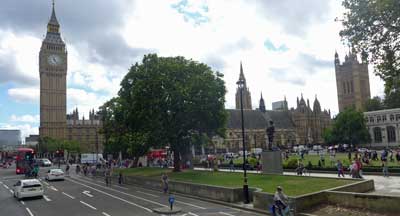
London highlights
- Big Ben and Parliament
- Westminster Abbey and St. Paul’s Cathedral
- Tower of London and Tower Bridge
- West End shows (Broadway equivalent) and classic pubs
- Buckingham Palace and Windsor Castle
Paris is actually far more beautiful than London and the food is famously much better as well. Since Paris gets so many tourists from non-French speaking countries, it’s easy to get by on just English, and the Metro system makes it fast and easy to get around. The architecture of both cities is amazing from the Tower of London, Big Ben, Westminster Abbey to the Louvre and the Eiffel Tower. These cities each pack a huge punch and they are very different from each other as well. Actually, England is arguably the best choice for your first trip to Europe.
Paris highlights
- Eiffel Tower
- Louvre Museum and Museum de Orsay
- Arc de Triomphe and other monuments
- Montmartre neighborhood and Sacré Coeur Cathedral
- Probably the world’s best affordable restaurants and wine
Best add-ons to London and Paris
- Edinburgh (2 or 3 nights, from London)
- Amsterdam (2 or 3 nights, from Paris)
- Bruges and Brussels (2 nights, from Paris)
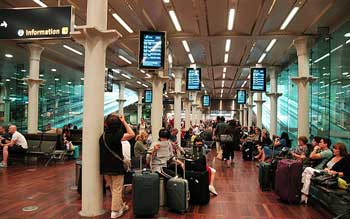
>>>Best one-week London and Paris itinerary in detail
>>>Check London hotel deals
>>>Check Paris hotel deals
Itinerary 2: England and Scotland
- London (3 or 4 nights)
- York (1 night)
- Edinburgh, Scotland (2 or 3 nights)
- Inverness, Scotland (2 or 3 nights)
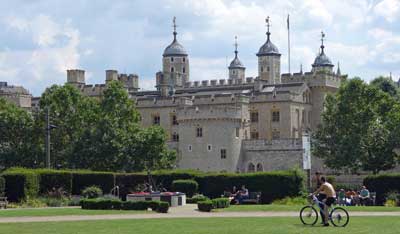
York is a small Roman city with intact city walls and one of the most famous cathedrals in Europe. Edinburgh is not only the capital of Scotland, but it’s easily the second most interesting city in all of Britain. If your time is short, skip York and spend more time in Edinburgh.
If you prefer to focus on the south of England on your first trip then the best option is to go to Bath or nearby Bristol after London. Bath is another of England’s top destinations and it’s a gorgeous city that has been a spa resort for many centuries. It’s also reasonably close to Stonehenge. You can also easily get to Cornwall in England’s southwest corner from Bath, and that’s a whole different and fascinating experience (with nicer weather than up north).
If you’ve got more than a week and want to spend more time in Scotland, especially in the summer months, the place to head to is Inverness. It’s a small town that is considered the gateway to the Scottish Highlands, but it’s an interesting and charming place on its own. You can take day-trips by bus to the highlights of the Highlands including the Isle of Skye and Loch Ness. Between you and me, it’s better to minimize time in Loch Ness or skip it altogether because it’s not one of the more photogenic parts of Scotland and the monster has always been a hoax.
Travel times between the recommended places
- London to York by train: 2 hours
- York to Edinburgh by train: 2.5 hours
- London to Edinburgh by train: 4 hours
- Edinburgh to Inverness by train: 3.5 hours
- London to Bath by train: 85 minutes
Best add-ons to England and Scotland
If you think you want to spend your whole trip in Britain you should have a look at our article on the best itineraries in England, Scotland, and Wales.
>>>Check London hotel deals
>>>Check Edinburgh hotel deals
Itinerary 3: Paris and Italy
- Paris (3 or 4 nights)
- Venice (1 night)
- Florence (2 or 3 nights)
- Rome (3 nights)
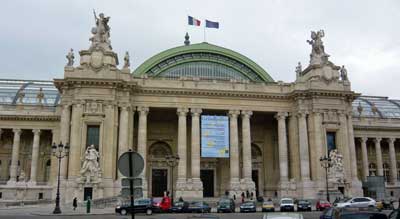
From Paris you can easily fly to Venice (or nearby Treviso) where you should try to spend about 24 hours. Venice is small enough to see in a full day, and so crowded that most people are satisfied to leave after that day. The key is to stay in the main part of the main island so you can enjoy Venice before the cruise passengers and day-trippers arrive, and also after they leave for the day. Two nights in Venice would not be wasted time, and it’s possibly the most gorgeous city in the entire world, but you can see the best of it in a bit over 24 hours.
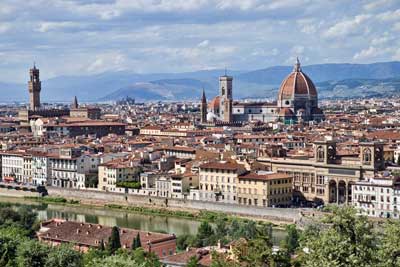
Rome also lives up to the hype and spending a day in the Vatican City will be a highlight even for non-Catholics, but it’s also a crowded and busy city so three days is usually enough for most people. Similar to Paris, Rome is an unusually beautiful city from almost any angle when you are in the historical center. You’ll walk through a stunning piazza (town square) and then turn a corner and you’ll see gorgeous buildings or public statues that are as nice as anything in the museums. Seriously, it’s worth a visit.
Paris to Venice flight: 1 hour 35 minutes
Venice to Florence by train: 1 hour 53 minutes
Florence to Rome by train: 1 hour 16 minutes
You can of course instead fly from Paris to Rome and then go north to Florence and then to Venice and fly home (or back to Paris) from there, and it would be just as enjoyable.
Best add-ons to Paris and Italy
France
- Nice/Cannes/Monaco (2 or 3 nights)
- Avignon (2 nights)
- Bourges (2 nights)
- Bordeaux (2 nights)
- Aix-en-Provence (2 nights)
- Reims (2 nights)
- Dijon/Burgundy (2 nights)
Italy
- Milan (1 or 2 nights)
- Lake Como (2 nights)
- Siena (2 nights)
- Cinque Terre (1 night)
- Naples/Sorrento/Amalfi Coast/Pompeii/Capri (3 to 5 nights)
- Sicily (3 to 4 nights)
>>>Much more information in this article about the best France and Italy itineraries
>>>Check Paris hotel deals
>>>Check Venice hotel deals
>>>Check Florence hotel deals
>>>Check Rome hotel deals
Itinerary 4: Mediterranean cruise
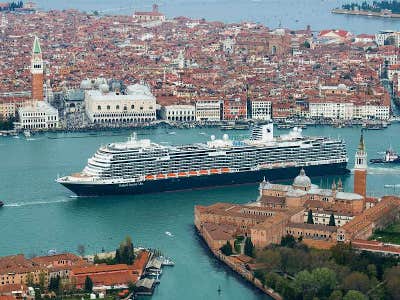
In spite of the reputation of cruises to be floating buffets, they can actually be an excellent way to visit a great number of amazing European cities in a short time. The ship typically is in port from the early morning until mid evening, often giving you the opportunity to have dinner in the city (unlike Caribbean cruises). Better still, the cruise ports are often near the center of town, so you can just walk off the ship and do sightseeing on foot or by public transportation.
Mediterranean cruises usually start at 7 nights but can go up to 3 weeks, which can provide an amazing tour of the entire region without having to pack and repack your bags more than once. They also can provide excellent value, especially compared to the price of taking trains or flights and finding new hotels in every destination.
Most popular Mediterranean departure ports
Barcelona, Spain – It’s an easy port to reach. Ships generally go from Barcelona with stops in France and then Italy.
Rome (Civitavecchia), Italy – The port isn’t very close to Rome, but it’s easy to get back and forth. Ships go west to France and Spain as well as south around the tip of Italy and then on to Croatia, Venice, and to Greece.
Venice, Italy – The cruise ships no longer dock close to the best tourist areas, but it’s easy enough to visit Venice for a day or two before boarding a ship. Ships starting in Venice go south and then head west and to Rome and then to France, or they go south to Croatia and then head east to Greece.
Athens, Greece – The cruise port of Piraeus is just south of Athens and easy to reach. Ships from Athens usually head west towards Croatia, Italy, France, and Spain, but there are also ships that visit Greek islands and Turkey.
>>>Check for deals on Mediterranean cruises
Alternative to consider: a river cruise
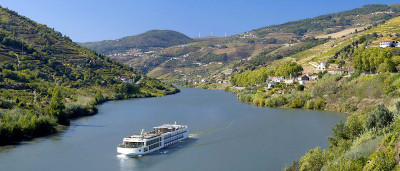
Amsterdam, Budapest, and Prague are some of the most popular river cruise ports, but there are dozens of others including many smaller towns in France where few other tourists will be when you stroll off the ship. There is little or no entertainment on the river cruise ships, but passengers don’t miss it because the entire day and into the evening is spent just steps from local cultural offerings and restaurants.
>>>Check for Europe and river cruise deals
Itinerary 5: France, Belgium, and Netherlands
Paris to Brussels: 1 hour 22 minutes
Brussels to Bruge: 58 minutes
Bruges to Amsterdam: 2 hours 45 minutes
Amsterdam to Paris: 3 hours 17 minutes
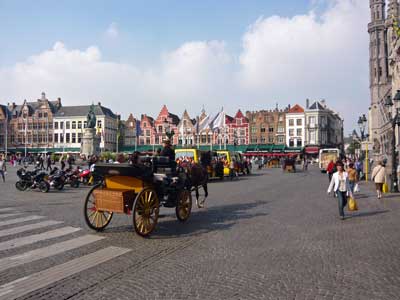
Spending 4 nights in Paris and 3 nights in Amsterdam would be a great trip, but if you want to see something else you’ve got a couple options in between. My advice is to spend an afternoon looking around the Grand Place (main square) in Brussels and then hop a 58-minute train ride to Bruges for a night or two. Brussels isn’t a great tourist city, but Bruges really is so it’s a better option for most people. Whatever you choose out of this group, you can be back in Paris on another high-speed train for your flight home.
Best add-ons to France, Belgium, and Netherlands
- Luxembourg City (1 or 2 nights)
- Cologne, Germany (1 or 2 nights)
- London (3 or 4 nights)
- Interlaken, Switzerland (2 or 3 nights)
>>>Check Paris hotel deals
>>>Check Bruges hotel deals
>>>Check Amsterdam hotel deals
Itinerary 6: Paris and elsewhere in France
- Paris (3 or 4 nights)
And a choice of:
- Nice/Cannes/Monaco (2 or 3 nights)
- Avignon (2 nights)
- Bourges (2 nights)
- Bordeaux (2 nights)
- Aix-en-Provence (2 nights)
- Reims (2 nights)
- Dijon/Burgundy (2 nights)
- Normandy (2 nights)
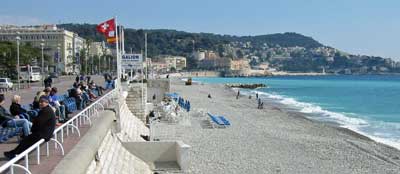
While Nice is a wonderful tourist city for a look at the French Riviera, the other larger cities of Lyon and Marseilles are probably better saved for a future trip because they are light on key sights compared to many smaller towns. Wine lovers can rent a car or take trains into Bordeaux or Burgundy. Since you can get between most of these towns by train in 2 hours or less, spending only 2 nights in each one is a reasonable option if you want to see a lot in a short time.
Normandy is an interesting choice and easy to reach in only about two hours by train from Paris. Some visitors like to see the famous WWII beaches and memorials, while others (especially in summer) like to check out one or more of the beach-resort towns. Deauville is one of the more famous of those, and it’s also famous for its horse race track and as one of the epicenters of the industry in Europe.
Best add-ons to Paris and elsewhere
- More France, of course
- London (3 or 4 nights)
- Interlaken, Switzerland (2 or 3 nights)
- Amsterdam (2 or 3 nights)
>>>Check Paris hotel deals
>>>Check Nice hotel deals
Itinerary 7: Italy
Rome to Florence: 1 hour 16 minutes
Florence to Venice: 1 hour 53 minutes
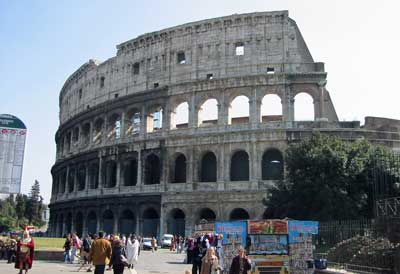
Venice is small enough that you can see the main sights in about 24 hours, and it’s so insanely crowded that many people tire of it after about a day as well. It’s better to pay more for a hotel to be on the main island and visit quickly than to save money with a hotel on the mainland where you’ll be in crowds going back and forth as well. Florence is the most relaxing of the 3, and also a great base for side trips to Pisa, Siena, and Cinque Terre, just to name a few.
Going to Italy? Here are the best first-time Italy itineraries for 3 days to 2 weeks (in much greater detail)
Best add-ons to Italy
- Milan (1 or 2 nights)
- Lake Como (2 nights)
- Siena (2 nights)
- Cinque Terre (1 night)
- Naples/Sorrento/Amalfi Coast/Pompeii/Capri (3 to 5 nights)
- Sicily (3 to 4 nights)
>>>Check Rome hotel deals
>>>Check Florence hotel deals
>>>Check Venice hotel deals
Itinerary 8: Spain
Madrid to Barcelona: 2 hours 30 minutes
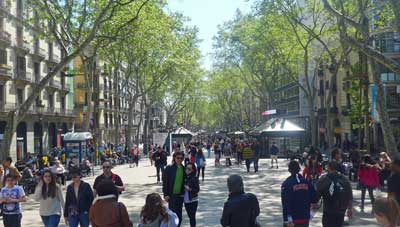
A huge part of Spain’s tourism industry is built around its southern beaches and islands such as Ibiza, Mallorca, and Tenerife (in the Canary Islands). For most people it’s best to ignore those places on your first trip because none of the beaches are special enough to spend days on them compared to the culture of the cities.
Best add-ons to Spain
By popular demand, I’ve added a full article on where to go in Spain with itineraries from 7 to 10 days up to two weeks.
>>>Check Madrid hotel deals
>>>Check Barcelona hotel deals
>>>Check Lisbon hotel deals
Itinerary 9: Germany
Berlin to Munich: 6 hours 2 minutes
Munich to Rothenburg ob der Tauber: 2 hours 56 minutes
Munich to Füssen: 2 hours 4 minutes
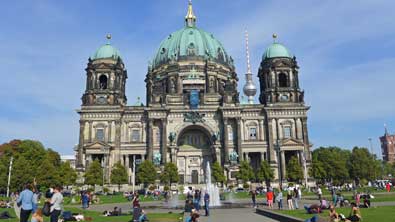
Those two cities are the keys to a Germany visit, and after that you’ve got a wide variety of choices. I cover most of the popular choices in my article on where to go in Germany, which covers several smaller towns that are major highlights.
Best add-ons to Germany
- Cologne (1 or 2 nights)
- Hamburg (2 or 3 nights)
- Amsterdam (3 nights)
- Prague (3 nights)
- Salzburg (2 or 3 nights)
- Vienna (3 nights)
- Interlaken, Switzerland (3 nights)
- Lucerne, Switzerland (2 or 3 nights)
>>>Check Berlin hotel deals
>>>Check Munich hotel deals
Itinerary 10: Switzerland
- Interlaken (3 nights)
- Bern (1 night)
- Lucerne (3 nights)
Zurich Airport to Interlaken: 2 hours 10 minutes
Interlaken to Bern: 53 minutes
Bern to Lucerne: 1 hour 50 minutes
Lucerne to Zurich Airport: 1 hour 3 minutes
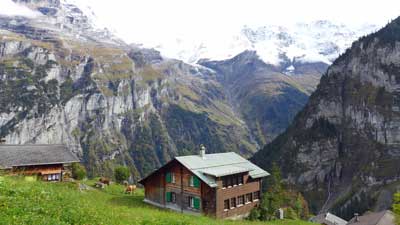
Interlaken is the best hub for the most dramatic Alps views and experiences. The one-hour cable car ride up to the Schilthorn observation deck is something you’ll never forget, and the only thing that might be more dramatic is the train ride up to the Jungfraujoch station, which is the highest in Europe. Lucerne is almost as beautiful with a scenic lake at its heart and also great mountaintop views nearby. If you do want to see a Swiss city then the capital of Bern is the most interesting and photogenic on a short visit. Read more about where to go in Switzerland for even more ideas.
Best add-ons to Switzerland
>>>Check Interlaken hotel deals
>>>Check Lucerne hotel deals
Itinerary 11: Eastern Europe’s best cheap cities
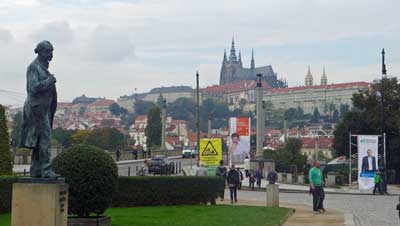
Each of these cities is beautiful and historic, but English is less widely spoken so they can also be quite a bit more challenging for a first-time visitor. Another difficulty is that the trains between them are still quite slow compared to the high-speed rail in the West, so it takes most of a day from one to another, and a bus is often a better choice. I cover this best cheap Europe itinerary more fully in the linked article.
Prague to Budapest: 6 hours 41 minutes
Budapest to Krakow: 9 hours 54 minutes (flying might be better)
Best add-ons to cheap Eastern Europe
- Cesky Krumlov, Czechia (2 nights)
- Ljubljana, Slovenia (2 or 3 nights)
- Split, Croatia (3 nights)
- Belgrade, Serbia (2 or 3 nights)
- Sarajevo, Bosnia and Herzegovina (2 or 3 nights)
- Sofia, Bulgaria (2 or 3 nights)
>>>Check Prague hotel deals
>>>Check Budapest hotel deals
>>>Check Krakow hotel deals


Hi Rodge,
My friend and I would like to do 8-10 day trip to Europe starting from the 23rd of December till NYE (exact dates depend on the ticket prices). We’ll be coming from Singapore. We would ideally like to go to Amsterdam and then go elsewhere to a city which has a different vibe, perhaps, Berlin (Amsterdam is not set in stone either). We would like the cities to have a good night life. Any recommendations?
Thanks,
Garima
Garima,
Amsterdam and Berlin both have excellent nightlife, and they are both very different from each other so they should be great choices. Amsterdam actually celebrates their big Christmas holiday early in December, so things won’t be shut down on 25 December like they will be in most other European places.
If you go to Berlin then you might also consider going on to Prague, which also has great nightlife and a lot to see. It will be chilly in Prague in late December, but still easy to get around. Paris is another great choice, although the nightlife can be harder to find if you don’t speak French (which I don’t). Still, it’s an amazing city in so many ways and only 3.5 hours from Amsterdam by high speed train. And London is only 2 hours from Paris on the Eurostar train, so you could do Amsterdam, Paris, and then London instead of Berlin and Prague. I hope this helps. Let me know if you have any other questions. -Roger
Hi Roger,
i have been trying make an itinerary for Europe since a long time,i’ve decided on dates from the 14th of Nov,till the 29th of Nov,29th ill be catching a flight back home so it leaves me with 15 days of sightseeing..i’ve zeroed in on Rome,Venice,Zurich,Interlaken,Paris and Amsterdam as the cities to visit..please share your thoughts if you think is it feasible enough too go 6 cities within a span of 15 days..the breakdown of the itinerary is as below:
1.Rome – 2 days
2.Venice – 2 days
3.Zurich – 2 days
4.Interlaken – 2 days
5.Paris – 3 days
6.Amsterdam – 3 days
Bharat,
The problem with staying in a city for only two nights is that you really only get one sightseeing day that way, and you end up spending half your days in transit. Venice is small enough to see in one or two days, but I’d stay 3 nights in the others. I would also recommend eliminating Zurich from the trip because it’s extremely expensive and there is not much to see. The real magic in Switzerland is the scenery, and Interlaken is the ideal base for that. If you keep Venice at a day or two and do 3 days in the others, this trip will work very well. Have a wonderful time. -Roger
Hi Roger,
I would really appreciate if you could share your expertise in getting most of our Europe trip. London is our fly in/fly out in July next year and we are planning to spend our last week in London/Ireland. We have 2 weeks to explore France, Germany & Switzerland and possibly Italy and then back to London. Total of 3 weeks excluding fly time. Hope to hear from you soon! By the way, I have a 10 y.o. so I am sure I would have to make that into consideration as far as places to go.
Thanks,
Sally
Sally,
So you’ve got about 14 days to plan and you want to visit France, Germany, Switzerland, and possibly Italy. In 14 days I would recommend visiting exactly 5 cities, and if you haven’t been there before I’d also say that Paris should be one of those cities for 3 or 4 nights.
That gives you 10 or 11 days for 4 more cities. If you want to include Italy I would recommend at least 7 days for that. The shortest trip I recommend is 1 night in Venice, 3 nights in Florence, and 3 nights in Rome. You could go to Paris and then take a train to Switzerland for 3 or 4 nights and then another train to Venice for a week in Italy.
If you wanted to save Italy for another trip and include Germany for a week in its place, you could go from Switzerland to Munich and then to Berlin, probably flying out of Berlin back to London. There are some other interesting options that you could consider in my article about where to go in Germany. Rothenburg ob der Tauber is a place you can enjoy on a visit of about 24 hours.
Or you could go from Paris down to Nice for a few days on your way to Italy. Hopefully at least one of these options sounds good to you. Let me know if you have any other questions. -Roger
Hello Roger,
I have been looking around for itinerary suggestions for Europe until I found your articles, been reading it and all the comments, I have never seen such detailed answer, you have been so helpful. So I told myself why not ask Roger, so here is my question 🙂 My husband and I will be visiting my daughter in Germany during her Winter break February 2017, she goes to school in Bieberach so we’ll most likely used the Stuttgart airport,nearest to her. We would like to visit Germany,London,Paris, and Switzerland during the stay. We will be there for 2 weeks. Can you give me some suggestions for a cost effective itinerary for this trip? Do you think 4 countries in 2 weeks is too much? I really appreciate your help. Thank you.
Leng
Leng,
I’m happy to help. Sorry for the delay in responding, but I’m in Beijing on a China trip right now.
I think it’s more helpful to think in terms of cities rather than countries. I’d recommend 3 or 4 days in London and 3 or 4 days in Paris. That gives you about 7 remaining days. The shortest visit to Switzerland that I’d recommend is 3 days, and you might find my article about where to go in Switzerland to be helpful with that. If you do those three things that would only leave you 3 or 4 days for Germany itself. You might also be interested in my article on where to go in Germany.
Once you choose the destinations you want to visit, it should be fairly easy to figure out the order to see them in and how to get there. I’m happy to help with that if you need it. -Roger
Thanks for the quick response 🙂
I totally agree with you. Our other options are:
–Arrive in Paris around 4pm on 17th dec.
–17th, 18th, 19th, 20th in Paris.
–Early morning Flight to Prague on 21st.
–21st, 22nd, 23rd in Prague
–24th, 25th, 26th, 27th in Budapest
–28th Fly back to home.
———————————————–
Day 1: Arrive in Barcelona
Days 2, 3, 4, & 5: Barcelona plus day trips
Days 6,7,8: Valencia or Seville
Days 9,10,11,12: Madrid
——————————————————————
Day 1: Arrive in Rome
Day 2,3,4,: Rome
Day 4: Rome, take a train to Florence in the evening
Days 5, & 6, 7: Florence and Tuscany
Day 8, 9, 10: Rome
Day 11 and 12: Venice
Day 13: Fly home
——————————————
Day 1: Arrive in Budapest
Day 2, 3, 4: Budapest
Day 5: Travel from Budapest to Vienna.
Day 5,6,7: Vienna
Day 8: Travel from Vienna to Prague
Day 9,10,11, 12: Prague
Day 13: Fly back home
Please advise if the above plans are better than my previous planned itinerary? This will be our first trip to Europe. I am very confused right now and need some help. Please help 🙂
Hi Roger,
Thank for this great article.
My wife and I are planning to travel to Europe from 16th Dec to 28th Dec this year for our honeymoon. We wish to visit the following cities but are not sure if it will be a bit much.
1. Munich – 2 days
2. Innsbruck – 1 day
3. Vienna – 1 day (can be removed)
4. Prague – 2 days
5. ?eský Krumlov – 1 day
6. Budapest-2/3 days
Could you help us with the following:
–Big question: Is December good month to travel to these places?
–If we have to miss one or two places, can you suggest the ones where we don’t waste too much time in travel?
— Which countries would be ideal for the dates that we plan to visit in the month of December?
–Are there any other places that are ideal for a visit during our travel dates and must be included in the itinerary?
Thank you in advance!
Rahul
Rahul,
December isn’t a great month for a trip like this because the days are short and it will obviously be quite cold. Still, it’s much better than staying home and you’ll have the nice Christmas decorations to enjoy.
I’d skip Innsbruck for sure. It’s mainly a ski town without much to see. Vienna might also be cut if you aren’t in the mood. You can’t see much of anything in one day in a large city like that. I’d probably also cut Cesky Krumlov and spend an extra day in Prague. I recommend 3 nights in almost any city you visit, so it’s better to visit 3 cities for 3 days each rather than 6 cities for a day or two each.
Here are my recommended best destinations in Europe in December. I’m happy to help if you have other questions. -Roger
Hi Roger , I am from India. Love ur website. A lot of effort has been put to answer queries which are so common and yet internet has such vague answers to them. Thanks for this website.
Now my query is. In may 2018 me ,my husband and my 4yr old twins then wish to make a week long trip to any one destination in Europe. We are tight on budget ,goals of the trip are to have a relaxed time with family ,kids should have a great time and we should be able to save on budget by using public transport. Could you suggest which place is good with 4yr old twins.
Shweta,
Thank you for the kind words. It sounds like this will be your first trip to Europe, and if that’s the case you might have a quick look at my advice about choosing a great Europe city rather than a cheap one. There are some excellent cities that are cheaper than others, but my main point is that it’s really not worth going to one of the cheapest cities instead of one that interests you far more.
With that in mind, you can cut costs in most cities by renting an apartment instead of a hotel, which also allows you to do some of your own cooking instead of expensive restaurant meals every day. On the other hand, 7 days is quite a long time to stay in most cities, and you might even consider going to another city as well.
My best suggestion would be Paris because it’s really amazing to see and experience, and if you find an affordable apartment it can be a budget-friendly place. The Metro system there is so good that you can stay a bit outside the city center and still get around quickly and easily.
If you are looking for something cheaper than that but still very worthwhile I would suggest Budapest or Prague. Lisbon is another great choice, as it’s a lovely city that is cheaper than most similar cities. Let me know if you had something different in mind and I’ll be happy to try to help more. -Roger
Hi Roger,
So happy I stumbled on your site, thank you, it is really interesting and informative! I am an active 62 year old, and can finally permit myself to do a little travelling. I have only been to Rome, Naples, and the Amalfi coast, since I have family in those regions.
I would like to visit other European cities and plan to travel alone in Oct/Nov 2017 for about 15 days departing from Ottawa. I also speak fluent French, Italian, as well as some Spanish. Safety and budget are a concern. What would you recommend?
Thank you,
Sue
Sue,
I’m glad you found this site as well. For a 15-day trip I’d recommend you plan on visiting exactly 5 cities. Since you’ve been to Italy before I’d recommend France as your main target, especially since you speak French. Needless to say, you will want to fly into Paris and spend 3 or 4 days there. The weather on the south coast in October and November is still pretty good so you could take a train down to Nice for a few days to explore not only Nice but also Monaco and Cannes, both of which are only about 20 minutes away by train. On the way you could explore the Loire Valley or Avignon or Bordeaux or any number of other places in France. I haven’t spent much time outside of Paris, Nice, and a few other places since I was a kid so it’s not my specialty. Or you could do what most other people do and just visit Paris and then leave the country.
From Paris it’s very easy to reach Amsterdam in a bit over 3 hours, or London in a bit over 2 hours on the Eurostar train. Both of those are top-tier destinations, but they are both a bit expensive as well.
Another option would be to take a train from Paris to Barcelona (perhaps stopping elsewhere in France on the way) and then spend the rest of your time in Spain. Your Spanish will be very helpful because English isn’t as widely spoken in Spain as it is in most of the rest of Europe. Spain would also be a cheaper option than the others, and have the best weather that time of year as well. I’d recommend Barcelona for 3 nights and Madrid for 3 nights at a minimum. You could also go to Valencia for 2 or 3 nights. Granada and Seville are the main attractions in the south of Spain for cultural tourists, and Toledo is a very worthwhile stop that can be done as a day-trip from Madrid. There are high-speed trains connecting all of these cities, including Paris to Barcelona, and the tickets are fairly cheap if you buy them at least a few weeks in advance, or maybe longer. Spain is great value, and all of the places I’ve mentioned are very safe. Pick-pocketing is far more common in Europe (especially in the south) than it is in the US or Canada, but nearly all other types of petty crimes and violent crimes are less common. As long as you are aware of the pick-pocketing issue, it’s easy to keep your things safe.
Those are my best recommendations based on what you’ve said. Let me know if you have any questions. -Roger
Hi Roger
My partner and I are planning a two week trip to Europe. I want to visit Italy for a week and then maybe go to France or Switzerland or even fly up to Amsterdam. Any suggestions? Thanks!
Ben,
For someone who wants to do the quickest visit to Italy that hits the main highlights you should plan on 3 nights in Rome, 2 (or 3) nights in Florence, and then 1 night in Venice, taking high-speed trains between them. You can take a train from Venice to Interlaken in Switzerland, and it’s one of the world’s great train journeys. I’d recommend 3 nights there, and if you want to see more of Switzerland you can do maybe 2 nights in Lucerne as well. From either one you can take a train to Paris in a reasonable amount of time (6 to 7 hours) and then spend 3 or 4 nights there. If you still have time then you could take a 3 hour 15 minute train from Paris to Amsterdam for 2 or 3 days. If you only have two weeks you won’t have time for ALL of that, so you’d either have to stay a couple days longer or cut something out. Let me know if you have any other questions. -Roger
Hi! I want to take a week long vacation to Europe from NY, I want to visit London, Paris & Spain. Since its my first time traveling to Europe how can I plan my trip without putting a hole in my pocket lol. Thanks in advance
Janett,
If you only have 7 days for your Europe visit I would focus on London and Paris, and save Spain for a future trip. That will save you some money since the cost of going back and forth to Spain would be quite a bit. Seven days is pretty much perfect for London and Paris, as it allows you 3 nights in one and 4 nights in the other, and it also allows you enough time to do a longer day trip from one of them and still have 3 sightseeing days.
The earlier you buy your Eurostar train ticket between London and Paris, the cheaper it will be (up to about 6 months in advance). Aside from that it will just be a matter of finding accommodations that offer everything you want for the lowest price. London is quite expensive for hotels and such, especially when you see how small the rooms tend to be. Paris is a bit cheaper and the Metro system is so good that you can stay a bit outside the center and still enjoy your visit. I’m happy to answer any other specific questions if you have them. -Roger